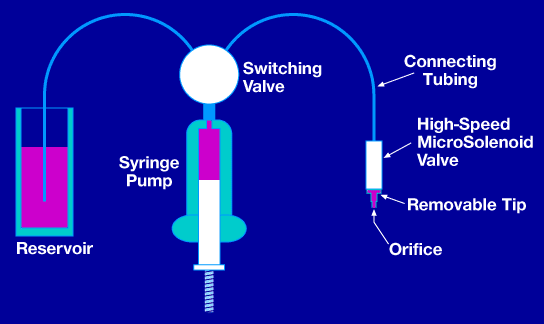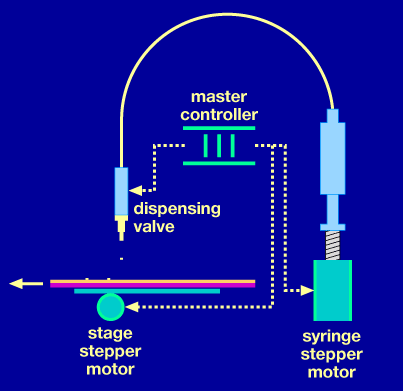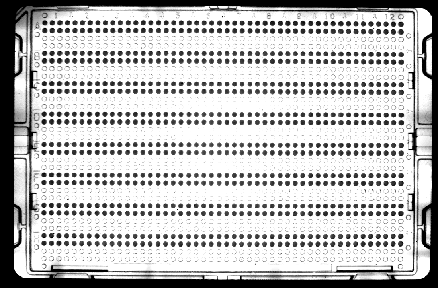synQUAD Technology
Cartesian Technologies has developed proprietary synchronized nanoliter quantitative aspirate-dispense (synQUADTM) technology which offers the following features:
- Quantitative high-speed non-contact dispensing of nanoliter volumes
- Precise placement of dispensed volumes on an x-y receiving matrix
- Wide dynamic range of dispensing volumes (50 nL to 8 µL)
- Ability to operate in either continuous dispense or aspirate/dispense mode
Non-Contact Nanoliter Dispensing
The technology couples the high-precision displacement capabilities of syringe pumps with high-speed actuation of micro-solenoid valves. A schematic of the basic dispensing mechanism is shown below:

synQUAD technology dispenses by having the syringe pump displace a quantitative amount of fluid. The displaced fluid creates a positive pressure, which is then released in a short burst by actuation of the normally-closed micro-solenoid valve. The rapid actuation of the valve produces a pressure - or acoustic - wave which, as it passes through the restrictive orifice at the tip, increases in linear velocity. When the linear velocity becomes high enough to overcome the surface tension of the solution, a droplet will eject from the tip. The volume of the droplet is the volume of fluid displaced by the syringe.
The dispense volume using synQUAD technology is a function of both the total syringe volume and the resolution of the stepper motor driving the syringe. For a 24,000 step motor, a 100 µL syringe provides a volume per step of 4.2nL. Syringe volumes of 250 µL and 500 µL yield volumes per step of 10.4 nL and 20.8 nL respectively.
Although the syringe pump system has the ability to displace volumes as low as 4.2 nL per step, ejecting such a small volume of liquid as a droplet is only achievable through Cartesian Technologies' proprietary coupling of a micro-solenoid valve.
synQUAD technology can be implemented in one of two modes of operation:
- Dispense only mode, for delivery of a single reagent type, and
- Aspiration and Dispense mode (A/D) for pickup and transfer of multiple reagents.
X-Y Synchronization
A second and equally important aspect of synQUADTM technology is precise synchronization of one or more dispensers with dynamic positioning of receiving media - multiwell plates, slides, or adsorptive matrix - on a supporting stage, shown schematically below:

A master controller synchronizes dispenser solenoids, stepper motors moving the stage, and stepper motors controlling the syringe pumps. The result is extremely rapid "on-the-fly" dispensing, similar to an inkjet printer.
Applications in High-Throughput Screening
As assays move from 96 to 384 and 1536 well plates, addition of reagents to these plates can be time-consuming. For example, delivery of 2 µL of reagent to a 1536 well plate with a 96-channel dispenser takes 16 transfers, each requiring a washing or disposal of the tips. The time required for these transfers is approximately 16 x 30 sec/dispense+wash or 8 minutes. With Cartesian Technologies' synQUAD technology, a 1536 plate can be filled with 2 µL per well in approximately 30 seconds. This 16-fold speed advantage, due to the high dispense rates as well as the non-contact nature of the dispensing, eliminates the need to wash between dispenses. In addition, the multi-channel capability of the system will allow multiple reagents to be dispensed.
synQUAD dispensing to Corning 1536-well plate:

100 nL each well: 2 rows sample, 2 rows blank
Application in DNA Microarrays
One of the rate-limiting aspects of creating genomic microarrays is the printing of the arrays. The transfer pin must move to each position, spot the sample, and move to the next position. With synQUAD technology, the dispenser can aspirate sample and dispense to a large number of arrays much more rapidly.
Copyright © 1998-2000
Cartesian Technologies, Inc.



 100 nL each well: 2 rows sample, 2 rows blank
100 nL each well: 2 rows sample, 2 rows blank